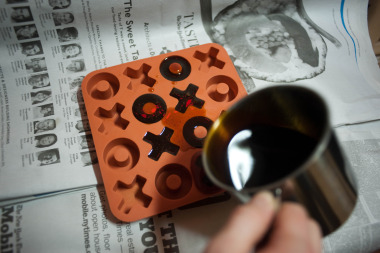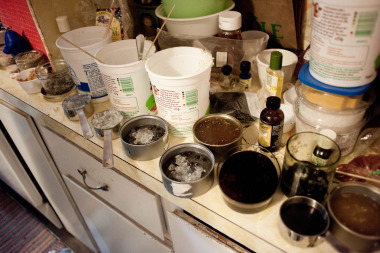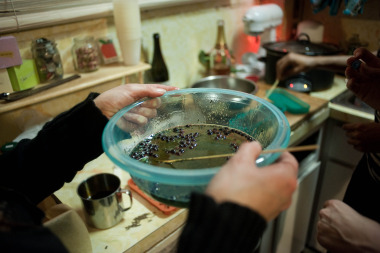Collective crafting: Melt & Pour soapmaking
 Photo courtesy of Jo Santangelo 2009
Photo courtesy of Jo Santangelo 2009
The Melt & Pour method is way easy and totally beginner friendly. Though you can do it on your own, it’s more fun to have a few friends to go in on additives and supplies, shipping costs (for the heavy soap base) and ideas!
Supply cost round up:
- Melt & Pour soap base=$6.50/2lb share (for our party’s calculations/person count)
- Essential Oils=possibly $0, since you probably already own at least one or two of these little vials
- Colors=$2 (bulk spices like tumeric and paprika are cheap)
- Objects=$4 (herbal teas are a great, cheap source for thoroughly dried flowers and herbs) And you can grind up groceries (like almonds, coffee and cocoa) for no/low cost additives
That’s a whopping $12 for a slab o’ gifts for all the folks on your list.
Here’s the DL on Melt & Pour soap partying
Step One: Identify a location to have your party. Ideally you know a pal who has a large kitchen and plenty of countertop or tabletop space. My house worked out just perfectly since the soap gang swelled and settled out at 12 attendees. Our kitchen is the biggest room in our house. (We live in a brownstone built in 1892, so our part of the house was the kitchen and servants quarters.)
 See, counterspace is essential. Room for materials and mixtures. Photo Jo Santangelo 2009. Step Two: Order a soap base for everyone, and insist upon attendees’ responsibility in claiming their shares (so you don’t get stuck with the bag.) We used this clear, glycerin soap base from Soapcrafters, but there are tons of other vendors out there. Just be sure the vendor you choose lists the ingredients in your soap base.
See, counterspace is essential. Room for materials and mixtures. Photo Jo Santangelo 2009. Step Two: Order a soap base for everyone, and insist upon attendees’ responsibility in claiming their shares (so you don’t get stuck with the bag.) We used this clear, glycerin soap base from Soapcrafters, but there are tons of other vendors out there. Just be sure the vendor you choose lists the ingredients in your soap base.

We received 35lbs of soap base and lopped off 2lb shares, leaving us with enough shares for everyone plus some extras for newly enthused soapmakers to take some home to practice.
Step Three: Have snacks and beverages. Craft parties are just like regular parties in terms of hostess duties, so make sure your bases are covered. Ask your guests to bring stuff potluck-style or ask them to chip in a couple bucks to help you out at the grocery store (since you don’t yet have cute soaps with which to barter for appetizers and eggnog.)
Step Four: Invite someone who knows what they’re doing. This is an important one not to overlook. Said person doesn’t have to be a total pro, but should have hopefully done this once before and be able to quell fears of bubbles, mixtures, add-ins, etc. Google is never far these days, so all you “invited experts” out there need not worry.

 The four-headed double boiler! Photo Jo Santangelo 2009.
The four-headed double boiler! Photo Jo Santangelo 2009.
Step Six: Add essential oil for scent. About a tablespoon per pound of base, so said the soap base people. Precision is overrated though; shake your oil(s) of choice in and stir it up. The base absorbs the scent, so you may find that after a good mix, the scent is nowhere to be found. Just add some more.
 Shake it a lot. Or pull off the drop-blocker thing that lives inside the pour spout of the oil for faster flavoring. Photo Jo Santangelo 2009
Shake it a lot. Or pull off the drop-blocker thing that lives inside the pour spout of the oil for faster flavoring. Photo Jo Santangelo 2009
Step Seven: Color and schwag. This is where things get really exciting.
 Rosebuds, lavender and bears! (ok, no bears.) Photo Jo Santangelo 2009
Rosebuds, lavender and bears! (ok, no bears.) Photo Jo Santangelo 2009
Think of herbal teas, exfoliants and other thoroughly dried objects that might be pretty encapsulated in a bar of soap. Here are some ideas we saw last night:
- coffee (ground before use) for color and texture
- powder raw cocoa (not a cocoa mix) for color
- tumeric or paprika spices for color
- culinary gold for color and PIZZAZZ
- dried lavender flower buds
- dried rosebuds
- dried hibiscus flowers (purchased as tea)
- dried chamomile flowers
- orange pekoe tea leaves
- poppy seeds
- fine cut oats
- dried orange rind (purchased in spice section)
You want to avoid organic matter (not-completely-dried things), stuff that has to be refrigerated, or other food items because you don’t want your soaps to be moldy after a few days.
Your chosen items will each have various propensities for floating, sinking and staying put as your soap molds dry. If you have a specific finished product in mind, test your plan by using a clear glass or plastic bowl (takeout containers work well for this) to experiment with desired colors and objects on a small portion of the soap base.
Step Eight: Pour into molds and let sit in the fridge overnight. Patrons may take their partially solidified molds home that night (hosts/esses be sure you have extra boxes lying around.)
I’d recommend take out containers, shoeboxes lined with parchment paper, plastic egg cartons, funky ice cube trays, to-go paper or plastic cups.
I’d avoid large lids with screwtops (your soap will mold itself into the grooves and become nearly impossible to eject gracefully), glass or rigid metal containers (since it was tough at times getting our stuff out of plastic that we could bend and abuse).
Step Nine: Pop and chop your solid soaps in the morning. Chop off any excesses or trailers from spillage. Chop large blocks of soap into individual bars. If you’re having trouble getting the soap out of the mold try sticking the whole thing in the freezer for a few minutes.
 Now wrap them up in shrink wrap, pretty paper or tissue paper and present your homemade delights to friends and fam. Photo Jo Santangelo 2009
Now wrap them up in shrink wrap, pretty paper or tissue paper and present your homemade delights to friends and fam. Photo Jo Santangelo 2009